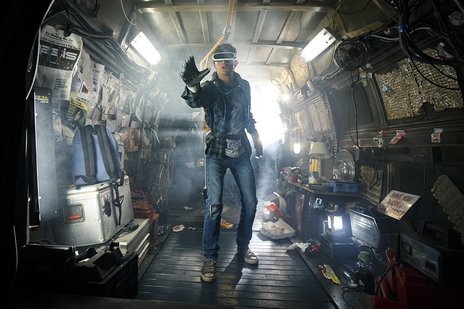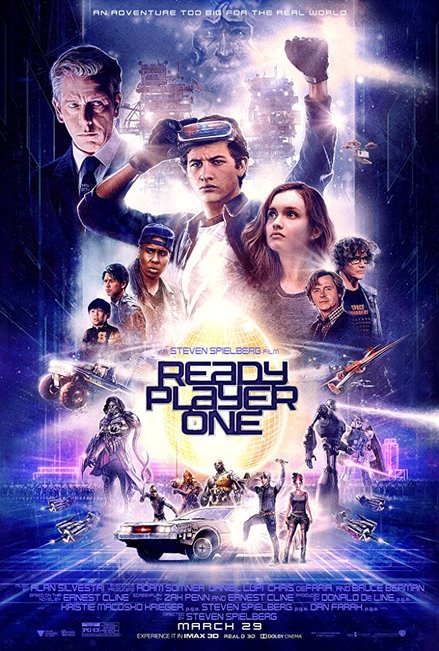Written by Scott Murray Ready Player One is exactly what I expected from a film adaptation of the book: a delightful, high-energy, entertaining, feast-for-the eyes adventure through pop culture history. It’s an exciting journey that, like the book it’s based on, is stuffed to the gills with references. Also like the book, you don’t need to worry about understanding them all from the get-go: the film will explain the plot crucial ones to you, and anything you catch along the way is an added bonus as a result of your personal pop-culture journey. Like the source book, everyone will have a slightly different experience based on which references they recognize and connect with, and part of the fun will be having your friends point out things you missed or share their own moments of excited recognition. Also, perhaps fittingly, Ready Player One is also a great example of the differences between the mediums of book and film, and how to take advantage of each to enhance your story. Let’s get one thing clear: if you know nothing about the book and are hoping for another classic Spielberg-ian romp where plucky heroes adventure their way to victory over evil, you’ve come to the right place. You’ll find all that plus a little more in Ready Player One. It’s another great example of Spielberg’s superb mastery over practical and computer-generated effects, both on their own and in combination, in a way that very few directors can hope to match. The story flows quickly and smoothly, and there’s always something new to look at. If you’re looking for another classic adventure, you can stop reading now and just go see the movie. If you’re looking for a more detailed breakdown, or are worried about some criticism you might have heard, keep on reading. Firstly, let me sooth any worry: the actors are all just fine. I’ve heard a few complaints that some of our main characters are a bit bland, but I don’t think that’s the fault of the actors at all. On the contrary, they’re pretty consistent with both the book and with adventure film heroes in general, reminding me of the kids from Jurassic Park or E.T. There’s been a trend in more recent films of that nature, like Super 8, to give the kids major character flaws or a more adult depth, and although Ready Player One doesn’t keep with that new tendency, it doesn’t feel lacking. On the contrary, it feels more in line with the older movies which provided so much inspiration to both book and film.  The plot is certainly streamlined. It moves along at a nice, quick pace, slowing only briefly for moments of subtle character or relationship development or for brief builds of suspense. The quick progression doesn’t leave much room for subplot, but the main story is satisfying and easy to follow. Indeed, if there had been more effort to include other subplots, the film may have become bogged down in half-developed threads the way many other book-to-film adaptations do. In choosing between cutting large parts of the book or leaving in too many half-baked bits so they drag down the main plot, this smoothed out approach is definitely the lesser evil. I’ve often heard a good book referred to as a three-course meal: in keeping with this metaphor, a movie and its runtime might only have one course to tell the same story. Rather than cramming appetizer, entrée, and desert onto one plate, creating an ungodly mess of flavors that taste awful together no matter how good the individual ingredients were, Ready Player One has instead chosen to simply provide you the best entrée it can, and it’s certainly better off for it. It may leave some viewers wanting more, but it’s definitely preferable to having the film collapse under its own weight. The actual premise is a familiar one, but re-dressed in new technological trappings: In a dystopian, resource-scarce and poverty stricken future, everyone on Earth makes lives for themselves inside the OASIS, a global computer program where you can do, or be, anything you want. The OASIS was the brainchild of James Halliday, a computer genius who, upon his death, left ownership of the OASIS to whoever could complete all the challenges, collect three keys and find a hidden ‘Easter Egg’ he left somewhere in the OASIS. Our adventurers are hoping to find the egg and take control of the OASIS not only for the glory and riches that come with it, but to ensure the OASIS and its glories remain free and open to everyone all over the world. To do so they’ll have to be faster than antagonist Nolan Sorrento and his army of ‘Sixers,’ all a part of the massive internet-provider mega-corporation that wants control of the OASIS, so it can restrict people’s access to the OASIS…unless they pay up. What follows is a familiar story of plucky underdogs standing up to the big faceless army of darkness given new life and entrancing spice thanks to the uniqueness and creativity of its setting: The OASIS provides for infinite possibilities, and the events which take place there are all covered in glorious visual spectacle. As far as changes from the book, there are actually quite a few including major plot events, character deaths, and even completely different challenges needed to complete the quest and find the egg. Some of these changes come from then need to fit into a film runtime, while others come as intentional changes meant to make the most out of the visual capabilities of cinema. This second reason is likely why the challenges were changed. For example, the first challenge in the book involves playing an old arcade game against a powerful and skilled opponent programmed by Halliday himself. While the thrill of a good arcade cabinet duel might excite former arcade rats, it isn’t much to look at on the big screen. The huge, obstacle-laden, gravity-defying race used as the first challenge in the film, on the other hand, presents so much incredible eye-candy that there is simply no wrong place to look: every inch of screen is covered in breathtaking spectacle. And, despite the mechanical changes, the actual solutions to the riddles and clues are still very much in the spirit of the book, eschewing brute force and thoughtless forward movement in favor of clever ideas and out-of-the-box thinking. These changes precipitate some others that all seem to flow naturally from earlier changes or from the need to keep runtime reasonable, and none of them were glaring enough to break my immersion or make me question the decisions. I did get the feeling that, if you really wanted to, you could sit down and pick out problems or plot holes in this film, but why would you? If you wanted to, you could do the same thing with other classic films, but the only purpose that would serve is to ruin the fun. Instead, choose not to. Choose to just enjoy the ride, and you’ll have plenty of fun.
0 Comments
Leave a Reply. |
Archives
March 2025
|
|
© 2012-2025, Nerds That Geek LLC.
All Rights Reserved. |
uWeb Hosting by FatCow


 RSS Feed
RSS Feed